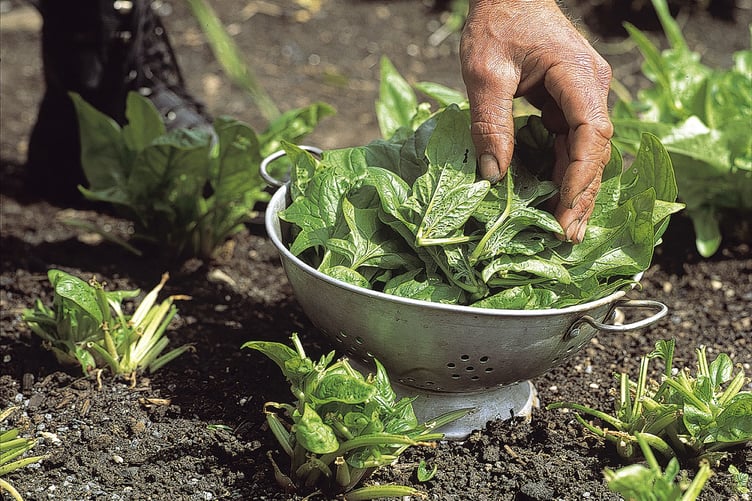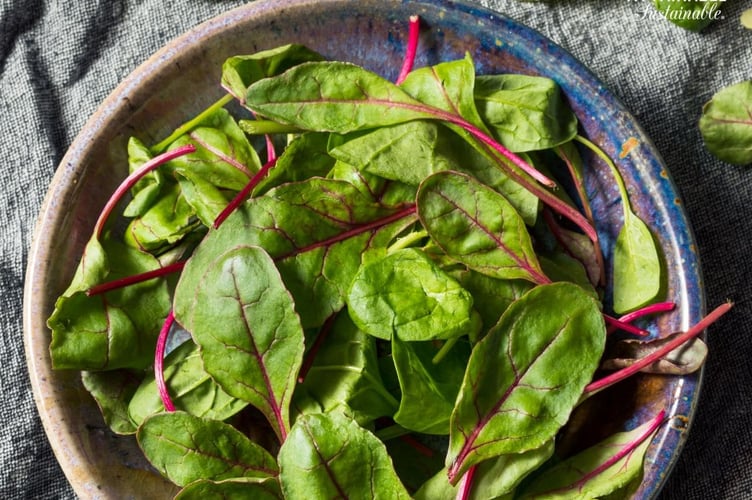This traditional gardening technique usually applies to salads, but there’s absolutely no reason why you shouldn’t feast off the tender outer leaves of plants like spinach, beetroot, radish, turnip and cabbage while they’re young. Then there’s the added bonus of getting more meals from them when they’ve matured later in the year.
Salad varieties are still the most popular “cut and come again” subjects, growing happily in window boxes or large pots, and there’s still time to plant seedlings which should keep you in fresh salad until early autumn.
If you are using containers - my neighbour uses a large but shallow tin bath. Fill with peat-free multi-purpose compost and pick a sunny and, if possible, wind-free spot. Start sowings in May if the weather is suitable.
Plant a range of varieties from, say, rocket and Little Gem, to the more exotic Australian Yellow Leaf and Butter Crunch, and you’ll not only get a colourful bowl of contrasting colours flavours and textures, but you can enjoy your home-grown produce at its peak - often only minutes after it’s picked.

With ‘cut and come again’, you just take a few outer leaves from each plant, leaving it to re-sprout for picking later. By keeping things cool and well-watered, cut-and-come again enthusiasts claim that they can get up to six or seven picking per plant.
It’s just common sense really. Harvest a plant by pulling it up, and that’s the end of it. With “cut and come again”, new leaves should be available every two weeks or so, depending on the weather and the time of year and getting multiple harvests per seed makes it excellent value.
When harvesting, use a pair of sharp scissions to shear off the outer leaves at their base, being careful to leave the growing point intact. Harvest regularly - the younger the leaves, the more tasty and tender they will be.
Some lettuces are specifically designed for cut-and-come again. These are non-heading leaf varieties, also known as loose-leaf, and are from two groups - Grand Rapids and Oakleaf.
The Grand Rapids group produces broad, crinkled and frilly leaves, while the Oakleaf varieties have flatter leaves.
Salad plants can become a bit tired after being picked for seven or eight weeks. Once the leaves begin to toughen or the plants run to seed, they will never recover their original flavour and succulence and should be replaced with a batch of new seedlings.
I used this system last year and the produce from two medium-sized containers kept the family in delicious fresh salad from late spring to mid-autumn.
If you plan to cut and come again this year, who not try something a bit different? There are dozens of unusual but easily grown plants like gold and green summer purslane, ice plants and red mizuna, giant red mustard and corn salad, which will brighten up any meal.
Midsummer sowings are often best for many East Asian leaves such as pak choi and komatsuma, as earlier crops can sometimes produce flowers rather than leaves - although you can eat these, too.
Lettuce is of course the mainstay of the traditional English salad but there are many lesser-known varieties which will happily grow again after being cut back. There’s mild buttery-tasting speckled lettuce, and Lamb’s lettuce, with delicate little leaves, Batavia lettuce with its unique crunch, and Arugula, also known as Italian cress.

It’s worth looking out for the fist-sized Bibb lettuce, which is beautifully sweet, and Boston lettuce which is soft and tasty and should be eaten when it’s really fresh.
If you can get around six times the usual harvest from a plant is it surprising that “cut and come again” is one of gardening’s fastest-growing trends?
JUST THE JOB
What to do in West Somerset gardens in July.
With most of the sowing and planting done, July is supposed to be a quiet month, but there always seems to be plenty of weeding, watering and pruning to keep us busy.
IN THE FLOWER GARDEN
Deadhead sweet peas, bedding plants and roses to keep them blooming.
Cut back hardy geraniums, delphiniums and deciduous magnolias to encourage new growth. Do the same to boost new growth in hanging baskets, followed by a nourishing feed.
Sow wallflowers, winter pansies, Sweet Williams and antirrhinums for next year’s displays
Remove the side-shoots from wisteria and train and tie in the new growth of other climbing plants.
Keep perennial borders tidy and trim back anything which is getting out of hand.
IN THE VEGETABLE GARDEN
Pot up strawberry runners in good compost while still attached to the parent plant. This will minimise root disturbance when transplanting in autumn.
Spray runner beans daily with water to ensure a good flower set.
Use lawn clippings around potato plants to stop tubers near the surface turning green.
Check for cabbage white butterfly eggs under brassica leaves and clear away any diseased or spent foliage.
A last sowing of French beans and carrots can be done in West Somerset. You can also transplant purple sprouting broccoli and winter leeks to their final positions.
Keep sowing seeds for salads as well as for autumn crop peas, and harvest courgettes before they get too big.
IN THE GREENHOUSE
To keep a supply of tomatoes going, flowers of upper trusses should be tapped by hand and sprayed with a fine water mist to aid pollination. Pinch out the side shoots each week and cut off any leaves growing beneath the lowest ripening fruit trusses to improve air circulation
Feed with tomato fertiliser once a week or more regularly if leaves begin to look pale or yellow.
The main danger in the greenhouse is over-heating so some shading will be worthwhile. Water first thing in the morning or in the evening to reduce water-loss through evaporation.
Tidy up fallen leaves and flowers to discourage the spread of fungal disease.
Vigorously-growing cucumbers should be given a liquid feed every 7-10 days.





Comments
This article has no comments yet. Be the first to leave a comment.